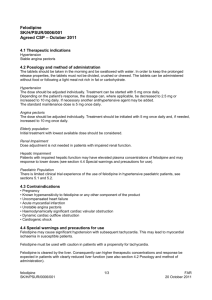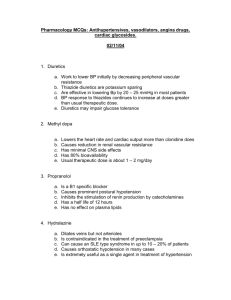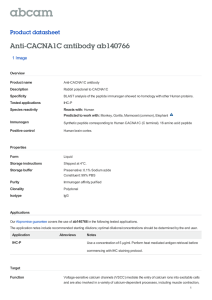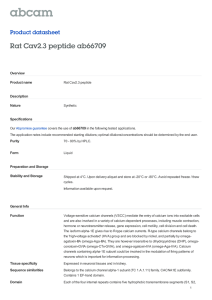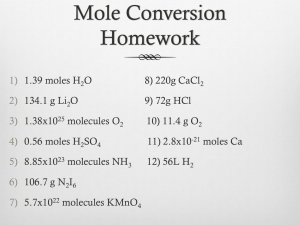Document 13309496
advertisement
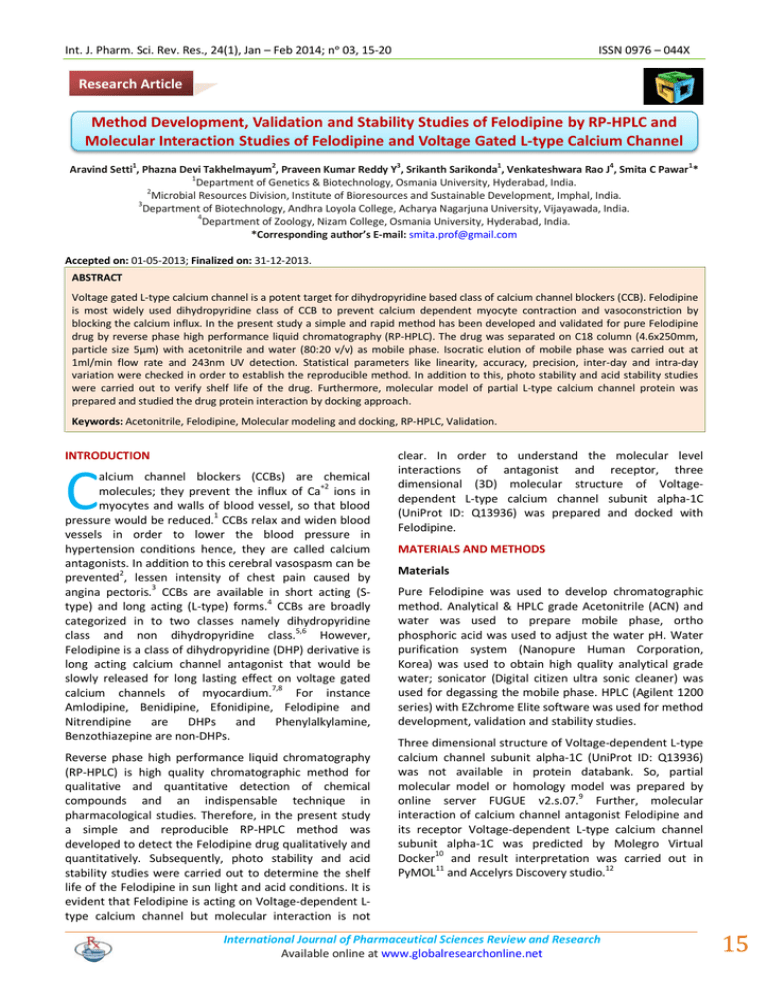
Int. J. Pharm. Sci. Rev. Res., 24(1), Jan – Feb 2014; nᵒ 03, 15-20 ISSN 0976 – 044X Research Article Method Development, Validation and Stability Studies of Felodipine by RP-HPLC and Molecular Interaction Studies of Felodipine and Voltage Gated L-type Calcium Channel 1 2 3 1 4 1 Aravind Setti , Phazna Devi Takhelmayum , Praveen Kumar Reddy Y , Srikanth Sarikonda , Venkateshwara Rao J , Smita C Pawar * 1 Department of Genetics & Biotechnology, Osmania University, Hyderabad, India. 2 Microbial Resources Division, Institute of Bioresources and Sustainable Development, Imphal, India. 3 Department of Biotechnology, Andhra Loyola College, Acharya Nagarjuna University, Vijayawada, India. 4 Department of Zoology, Nizam College, Osmania University, Hyderabad, India. *Corresponding author’s E-mail: smita.prof@gmail.com Accepted on: 01-05-2013; Finalized on: 31-12-2013. ABSTRACT Voltage gated L-type calcium channel is a potent target for dihydropyridine based class of calcium channel blockers (CCB). Felodipine is most widely used dihydropyridine class of CCB to prevent calcium dependent myocyte contraction and vasoconstriction by blocking the calcium influx. In the present study a simple and rapid method has been developed and validated for pure Felodipine drug by reverse phase high performance liquid chromatography (RP-HPLC). The drug was separated on C18 column (4.6x250mm, particle size 5µm) with acetonitrile and water (80:20 v/v) as mobile phase. Isocratic elution of mobile phase was carried out at 1ml/min flow rate and 243nm UV detection. Statistical parameters like linearity, accuracy, precision, inter-day and intra-day variation were checked in order to establish the reproducible method. In addition to this, photo stability and acid stability studies were carried out to verify shelf life of the drug. Furthermore, molecular model of partial L-type calcium channel protein was prepared and studied the drug protein interaction by docking approach. Keywords: Acetonitrile, Felodipine, Molecular modeling and docking, RP-HPLC, Validation. INTRODUCTION C alcium channel blockers (CCBs) are chemical molecules; they prevent the influx of Ca+2 ions in myocytes and walls of blood vessel, so that blood pressure would be reduced.1 CCBs relax and widen blood vessels in order to lower the blood pressure in hypertension conditions hence, they are called calcium antagonists. In addition to this cerebral vasospasm can be prevented2, lessen intensity of chest pain caused by angina pectoris.3 CCBs are available in short acting (Stype) and long acting (L-type) forms.4 CCBs are broadly categorized in to two classes namely dihydropyridine class and non dihydropyridine class.5,6 However, Felodipine is a class of dihydropyridine (DHP) derivative is long acting calcium channel antagonist that would be slowly released for long lasting effect on voltage gated calcium channels of myocardium.7,8 For instance Amlodipine, Benidipine, Efonidipine, Felodipine and Nitrendipine are DHPs and Phenylalkylamine, Benzothiazepine are non-DHPs. Reverse phase high performance liquid chromatography (RP-HPLC) is high quality chromatographic method for qualitative and quantitative detection of chemical compounds and an indispensable technique in pharmacological studies. Therefore, in the present study a simple and reproducible RP-HPLC method was developed to detect the Felodipine drug qualitatively and quantitatively. Subsequently, photo stability and acid stability studies were carried out to determine the shelf life of the Felodipine in sun light and acid conditions. It is evident that Felodipine is acting on Voltage-dependent Ltype calcium channel but molecular interaction is not clear. In order to understand the molecular level interactions of antagonist and receptor, three dimensional (3D) molecular structure of Voltagedependent L-type calcium channel subunit alpha-1C (UniProt ID: Q13936) was prepared and docked with Felodipine. MATERIALS AND METHODS Materials Pure Felodipine was used to develop chromatographic method. Analytical & HPLC grade Acetonitrile (ACN) and water was used to prepare mobile phase, ortho phosphoric acid was used to adjust the water pH. Water purification system (Nanopure Human Corporation, Korea) was used to obtain high quality analytical grade water; sonicator (Digital citizen ultra sonic cleaner) was used for degassing the mobile phase. HPLC (Agilent 1200 series) with EZchrome Elite software was used for method development, validation and stability studies. Three dimensional structure of Voltage-dependent L-type calcium channel subunit alpha-1C (UniProt ID: Q13936) was not available in protein databank. So, partial molecular model or homology model was prepared by online server FUGUE v2.s.07.9 Further, molecular interaction of calcium channel antagonist Felodipine and its receptor Voltage-dependent L-type calcium channel subunit alpha-1C was predicted by Molegro Virtual Docker10 and result interpretation was carried out in PyMOL11 and Accelyrs Discovery studio.12 International Journal of Pharmaceutical Sciences Review and Research Available online at www.globalresearchonline.net 15 Int. J. Pharm. Sci. Rev. Res., 24(1), Jan – Feb 2014; nᵒ 03, 15-20 Methods Chromatographic conditions HPLC system (Agilent 1200 series) contains an easy user interface EZchrome Elite software, auto injector and agilent photodiode array detector (DAD). Waters symmetry C18 column (25cmX4.5mm, 5µ) was used for isocratic elution of mobile phase, consisting of ACN and water (80:20 v/v) at flow rate of 1ml/min. Mobile phase was filtered with 0.2µm PTFE filter under vacuum, then degassed in sonicator. All the samples were analyzed at room temperature and separations were monitored at 243nm with 10 minutes run time. Method development Initial standard stock solution of 10mg/ml Felodipine was prepared in mobile phase. Further dilutions were prepared from the initial stock solution and stored in 200C. 100µg/ml concentration was used to develop the method by applying different solvent ratios and flow rates. The optimized chromatogram is shown in figure 1. Validation of the method As a standard procedure for HPLC, developed method ought to be validated to ensure the reliability and reproducibility of method. In general linearity, accuracy and precision studies are significant. Linearity Aliquots of 100, 50, 25, 12.5, 6.25 µg/ml were prepared from initial standard solution of 10mg/ml by serial dilution approach. In each well of auto sampler tray 200µl of diluted solution was loaded, however 20µl was being injected to C18 column. All measurements were repeated for three times to ensure the repeatability. Finally calibration curves of area under curve versus concentration were recorded. Accuracy Accuracy of the developed method can be determined by three different concentrations (+ 30 %). Triplicates of 70, 100, 130 µg/ml concentrations were analyzed and measured the area under curve. The found amount of Felodipine in each of these triplicates, were calculated by using formula described under assay content. However (+ 10%) 90% to 110% of recovery is relatively fair. Precision Repeated chromatographic analysis of Felodipine drug was performed to ensure the reproducibility with precision. In the present study 50µg/ml analyte was used for intraday and 25µg/ml analyte was used for inter-day precision. Results were statistically analyzed and tabulated. ISSN 0976 – 044X degradation methods to determine the shelf life of the molecule. In the present study photo degradation and acid degradation studies were carried out. 10 samples (each sample contains 100µg/ml concentration) of Felodipine were exposed to sunlight from 0 hour to 10th hour, during the experiment samples were collected with one hour interval in photo degradation studies. In addition to this, 60minute acid stability was accomplished with 0.5M HCl that was prepared in ACN, in this set up 100µg of Felodipine was dissolved in 1ml of 0.5M HCl and samples were collected with 1-10minute interval and 1060minute intervals. All collected samples were air dried by gentle blowing of air and dried drug was dissolved in 200µl of mobile phase. Finally all samples were analyzed under developed method conditions and chromatograms were recorded, calculated the recovery percent and degradation percent. Molecular Modeling & Docking Biological function of a protein is often associated with its structure. However, preparation of three dimensional crystal structures is tedious and expensive process. X-ray crystallography is the widely used technique to determine the 3D model of a protein but, crystallization of protein is highly challenging. In fact, 3D structure of Voltage gated L-type calcium channel (UniProt ID: Q13936) a potential target for CCBs including Felodipine, is not available on the protein data bank (PDB). Thus, sequence was collected from UniProt13 and homology model was prepared. Homology preparation includes identification of right template with good crystal structure, model generation and model validation. Template identification was performed by position specific iterative blast (PSIBLAST)14 but good quality template was not detected, hence FUGUE v2.s.07 online server (http://tardis.nibio.go.jp/fugue/prfsearch.html) was used. Protein FASTA sequences of query and template were aligned to check the amino acid conservation as shown in the figure 2. FUGUE server can model the protein based on sequence structure comparison with improved specific substitution tables, automatic alignment of detailed structure dependent gap penalties and combined information of multiple sequences and structures. The generated model was shown in figure 3. Model quality was checked by Procheck.15 Molecular docking is an indispensable approach to predict the interaction between ligand and protein. In literature interaction analysis between calcium channels and CCBs is not available. Therefore, Voltage gated L-type calcium channel and Felodipine a CCB was studied to understand the CCB and amino acid residue interaction. Molegro virtual docker was used for docking and interaction analysis. Stability Studies RESULTS AND DISCUSSION Stability studies are common in approved drugs in order to check the rate of physical changes in the intact drug. In general, chemical molecules are subjected to forceful Chromatography is fundamental technique in separation biology and qualitative, quantitative detection of chemical compounds. In the present study HPLC was used International Journal of Pharmaceutical Sciences Review and Research Available online at www.globalresearchonline.net 16 Int. J. Pharm. Sci. Rev. Res., 24(1), Jan – Feb 2014; nᵒ 03, 15-20 to identify Felodipine compound for that a method was developed and validated. Table 1: Recovery percentage of Felodipine in accuracy studies Injected Concentration (µg/ml) Area under curve Amount Recovered (µg/ml) Recovery % 70 100 130 4917684 7162644 9289524 69.86 100.2 129.74 98.6 100.2 99.8 Table 2: Intra-day and inter day precision of Felodipine in different intervals Time in Hours Intra-day precision Injected Area under concentration curve 0 1 50 50 2 3 4 5 50 3548244 50 3569844 50 3490644 50 3435924 Mean Concentration 50.02 Standard Deviation 0.97 Time in Days 3649044 3605844 Inter-day precision Injected Area under concentration curve 1 2 3 4 5 25 25 25 25 25 1746804 1663284 1755444 1742484 1722324 6 25 1784244 Mean Concentration 24.82 Standard Deviation 0.51 Recovered Concentration 51.40 50.80 50.00 50.30 49.20 48.44 Recovered Concentration 24.98 23.82 25.10 24.92 24.64 25.50 Further, molecular interaction between calcium channels and CCBs was studied by molecular docking studies. Molecular docking reveals the specific interaction between amino acid residues in the active site of protein and ligand molecule with appropriate pose. ISSN 0976 – 044X Despite of molecular interaction docking also gives binding strength in the form of docking score and/or free energy score that allows improving the ligand skeleton and its functional group choice. Chromatographic method was developed for Felodipine. Retention time of Felodipine is 5.76 minutes, detection is monitored at 243nm and its optimized chromatogram is shown in figure 1. The developed method was shown linear response to Felodipine drug within the concentration range of 6.25 – 100 µg/ml. Linear equation was generated by taking concentration of drug on X axis and peak area under curve on Y axis, found perfect positive regression equation is y = 72000x – 51756 and regression R2 value is 1 as shown in the figure 4. This linear equation can be used to predict the unknown concentrations in the quality control studies. Accuracy of Felodipine recovery was checked and it was recovered in the range of 98.6-100.2% for various concentrations as shown in the table 1. Intra-day and inter day precision studies were performed to check the precision of the developed method in different intervals of the same day and different days as shown in the table 2. Standard deviation (SD) of intra-day precision was found to be 0.9 and inter-day precision was found to be 0.5 that indicates precision values are very close to ideal concentration and not deviated from the injected concentration. Stability studies were performed to know stability of Felodipine under sun light and acidic conditions, results are shown in figure 5. Felodipine concentration was decreased with an increased exposure of sun light. Drug was remaining intact till fifth hour with the loss of 20%. However, 80% loss was observed after tenth hour as shown in figure 5a. In addition to this at sixth hour extra peaks were observed in chromatogram that indicates the possibility of drug degradation. Acid stability studies were performed with 0.5M HCL Acetonitrile solution and results are shown in figure 5b, drug was remaining intact till third minute, after that nearly 40% of drug was lost and extra peaks were observed in chromatograms. In conclusion, loss of intact Felodipine drug was noticed after fifth hour in photo stability studies and third minute in acid stability studies. Figure 1: Optimized detection of Felodipine at 243nm with retention time of 5.76 minutes. International Journal of Pharmaceutical Sciences Review and Research Available online at www.globalresearchonline.net 17 Int. J. Pharm. Sci. Rev. Res., 24(1), Jan – Feb 2014; nᵒ 03, 15-20 ISSN 0976 – 044X Figure 2: Pair wise sequence alignment of query (Voltage-dependent L-type calcium channel subunit alpha-1C) and template, obtained from FUGUE server. Identity, strong similarity and weak similarity of amino acid residues are shown in cyan, purple and pink colors respectively. Figure 3: Partial structure of Voltage-dependent L-type calcium channel subunit alpha-1C (450 amino acids) from 1,091 to 1,550 out of 2,221 amino acids was modeled in FUGUE v2.s.07 online server. The structure is shown ribbon view (Helix – Red, Sheet – Cyan, Turn – Green, Coil - Gray) as well as transparent surface view. Figure 4: Felodipine concentration vs. obtained peak area in HPLC was plotted on graph. Perfect positive regression (y = 2 72000x – 51756) was observed and R value is 1. International Journal of Pharmaceutical Sciences Review and Research Available online at www.globalresearchonline.net 18 Int. J. Pharm. Sci. Rev. Res., 24(1), Jan – Feb 2014; nᵒ 03, 15-20 ISSN 0976 – 044X Figure 5: Stability studies of Felodipine. 5a) Photo stability – Felodipine concentration was decreased with an increased exposure of sun light. Drug was remaining intact till fifth hour with the loss of 20% and 80% loss was observed after tenth hour. 5b) Acid stability – Felodipine was remaining intact till third minute, after that nearly 40% of drug was lost. Figure 6: Molecular docking of voltage gated calcium channel and CCB. 6a) Active site was shown in green color mesh in the modeled voltage gated calcium channel. 6b) Chemical structure of Felodipine (CCB) antagonist used for molecular docking. 6c) Docked pose of Felodipine in active site of Voltage-dependent L-type calcium channel subunit alpha-1C, active site residues are labeled. 6d) Felodipine is decently accommodated in the active site, surface view of protein (yellow color) and stick view of drug is shown. Partial homology model (450 amino acids) of Voltage gated L-type calcium channel (UniProt ID: Q13936) (figure 3) was prepared in FUGUE online server from 1,091 to 1,550 out of 2,221 amino acids and alignment of query and template is shown in figure 2. Active site of the protein spanned in the modeled protein as shown in figure 6a. Model quality was checked in procheck, no residues were found in disallowed region of Ramachandran plot that indicates generated 3D model is error free. Molecular docking was performed between Voltage gated L-type calcium channel and its antagonist Felodipine (figure 6b), Moldock score and RMSD (Root Mean Square Deviation) were found to be -129.688 and 0.3477. Docked pose of Felodipine in active site is shown in figure 6c, nearest neighbor residues are labeled around the drug (Leu 323, Leu 324, Leu 325, Val 326, Gly 341, Ala 344, Leu 345, Thr 348, Thr 349, Glu 350, Gln 358, Phe 360, Pro 361, Gln 362, Pro 385, Gly 386, Lys 387, Ala 431, Val 432, Ile 433, Met 434, Phe 437, Asp 438, Tyr 439) and Hbond (2.6683 Ao) was found between Glu 350 and N of Felodipine. Pocket of active site is decently accommodated Felodipine, surface view of protein and stick view of drug is shown in figure 6d. CONCLUSION A simple and reproducible method was developed for the Felodipine by RP-HPLC. Method was statistically validated and found to be good. Further, photo stability and acid stability studies were performed to determine the shelf life of the Felodipine under sun light and acidic (HCl) conditions. However, drug is stable till fifth hour under sunlight and third minute in acidic conditions. In addition to this, active site region of Voltage-dependent L-type calcium channel subunit alpha-1C partial 3D model (450 amino acids) was prepared and model quality was checked by Ramachandran plot. However, model was International Journal of Pharmaceutical Sciences Review and Research Available online at www.globalresearchonline.net 19 Int. J. Pharm. Sci. Rev. Res., 24(1), Jan – Feb 2014; nᵒ 03, 15-20 found to be error free. Modeled calcium channel was used for protein ligand docking that reveals the molecular interaction between CCBs and calcium channels. In conclusion, HPLC method for Felodipine found to be good and adoptable for quality control studies and pharmacokinetic studies, generated partial 3D model of calcium channel offers researchers to develop better CCBs and eventually, molecular docking studies reveals the molecular interaction between CCBs and calcium channels that aids to improve the drug properties. REFERENCES 1. Hansen PB, Functional and pharmacological consequences of the distribution of voltage-gated calcium channels in the renal blood vessels, Acta Physiol, 207, 2013, 690-699. 2. Mani BK ODJ, Kumar L, Brueggemann LI, Ross M, Byron KL, Vascular KCNQ (Kv7) potassium channels as common signaling intermediates and therapeutic targets in cerebral vasospasm, J Cardiovasc Pharmacol, 61, 2013, 51-62. 3. 4. 5. Shu de F DB, Lin XF, Wu TX, Liu GJ, Long-term beta blockers for stable angina: systematic review and meta-analysis, Eur J Prev Cardiol, 19, 2012, 330-341. Alcocer L BM, Acosta J, Urina-Triana M, Use of calcium channel blockers in cardiovascular risk reduction: issues in Latin America, Am J Cardiovasc Drugs, 10, 2010, 143-154. McDonagh MS EK, Peterson K, Drug Class Review on Calcium Channel Blockers: Final Report [Internet], Drug Class Reviews, 2005, 4. 6. Basile J, The role of existing and newer calcium channel blockers in the treatment of hypertension, J Clin Hypertens, 6, 2004, 621-629. 7. Antonicelli R OS, Giovanni DC, Ansuini R, Mori A, Gesuita R, Parati G, Paciaroni E, Smooth blood pressure control ISSN 0976 – 044X obtained with extended-release felodipine in elderly patients with hypertension: evaluation by 24-hour ambulatory blood pressure monitoring, Drugs Aging, 19, 2002, 541-51. 8. Todd PA FD, Felodipine, A review of the pharmacology and therapeutic use of the extended release formulation in cardiovascular disorders, Drugs, 44(2), 1992, 251-277, 9. Shi J BT, Mizuguchi K, FUGUE: sequence-structure homology recognition using environment-specific substitution tables and structure-dependent gap penalties, J Mol Biol, 10, 2001, 243-257. 10. Thomsen R CM, MolDock: a new technique for highaccuracy molecular docking, J Med Chem, 49, 2006, 33153321. 11. The PyMOL Molecular Graphics System, Version 1,3, Schrödinger, LLC. 12. Accelrys Software Inc,, Discovery Studio Modeling Environment, Release 3,5, San Diego: Accelrys Software Inc, 2012. 13. Consortium TU, Reorganizing the protein space at the Universal Protein Resource (UniProt), Nucleic Acids Res, 40, 2012, D71-D5. 14. Altschul SF MT, Schäffer AA, Zhang J, Zhang Z, Miller W, Lipman DJ, Gapped BLAST and PSI-BLAST: a new generation of protein database search programs, Nucleic Acids Res, 25, 1997, 3389-33402. 15. Laskowski RA, Macarthur MW, Moss DS, Thornton JM, PROCHECK: a program to check the stereochemical quality of protein structures, J Appl Cryst, 26, 1993, 283-291. Source of Support: Nil, Conflict of Interest: None. International Journal of Pharmaceutical Sciences Review and Research Available online at www.globalresearchonline.net 20
